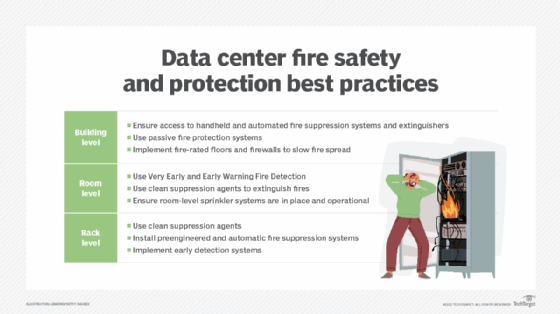
Victor/Adobe Stock
Use NFPA data center standards to help evade fire risks
A fire in a data center can damage equipment, cause data loss and put personnel in harm's way. Look to NFPA fire protection guidelines to hedge your risk against data center fires.
Fire protection for data centers is complex. Reliability and business continuity are essential, and organizations should look to minimize the impact of any fire suppression and detection systems if activated. Fire can strike digital equipment, wires, cables, HVAC systems, raised floors, suspended ceilings and other combustible materials found in data centers.
Many data center facilities design fire protection systems based on National Fire Protection Association (NFPA) guidelines 75 and 76. These guidelines outline appropriate measures for fire protection, suppression and life safety for facilities housing IT and telecommunications systems. They are considered the first line of defense from fire.
NFPA 75 vs. NFPA 76
NFPA 75 covers IT equipment, facilities and facility occupants. The guideline is the Standard for the Fire Protection of Information Technology Equipment.
The NFPA 76 guideline, the Standard for the Fire Protection of Telecommunications Facilities, also covers data centers since they include telecommunications equipment. It includes fire protection for facilities, equipment and service continuity that provide telephone, data, internet transmission, wireless and video services to the public.
Since data center facilities contain equipment and systems included in both guidelines, look at both standards when assessing and crafting fire protection plans. NFPA 75 applies to private network fire protection in a data center, and 76 applies to any public network equipment. The guidelines are updated every four years, and the next update is scheduled for 2024.
Fire protection in the data center
Given the numerous fire hazards in data centers, fire protection is necessary at three levels: the building, room and rack levels.
1. Building level
Building-level fire protection methods for data centers include fire sprinkler systems, handheld extinguishers and passive fire protection systems, such as fire-rated floors and firewalls that delay fire spread. Both NFPA 75 and 76 reference the NFPA's building construction rules for fire protection at this level. They outline the guidelines for sprinklered or nonsprinklered buildings, how the data center must be separated from other occupancies in mixed-use buildings, the use of noncombustible building materials and more.
2. Room level
At the room level, NFPA requires fire detection systems and sprinkler systems to be present in all data center rooms. The type of system is left to the discretion of the facility owner but includes the following:
- Very Early and Early Warning Fire Detection systems that can trigger fire suppression at the earliest sign of a fire and minimize damage; and
- clean agent suppression systems that use inert gases or clean agents to extinguish or suppress fires without damaging IT equipment.
3. Rack level
The third level is focused on the individual racks and other specific IT equipment housed in the data center. Early fire detection is difficult in a data center because many IT and electrical components are fully enclosed in cases and cabinets. Fires that go undetected can become a larger hazard.
Rack-level fire protection methods include preengineered and automatic fire suppression systems that are installed within the equipment itself. They can detect and suppress fires before the room- or building-level fire systems detect them.

In a preengineered system, fire detection tubing is routed within the rack and is connected to a cylinder with a clean suppression agent. The tubing detects a fire that starts in the rack and releases the clean agent immediately. This way, potentially, only the individual asset or, at most, the single rack is affected and the rest of the data center is protected from damage.
Other fire safety standards and best practices
Fire safety goals for data centers should always consider life safety, property protection and business continuity. At a bare minimum, data centers should meet NFPA 75 and 76 guidelines.
Additional fire protection standards and best practices include the following`:
- Common spot-type smoke detectors in noncritical areas are reliable and minimize false alarms.
- Pre-action wet sprinkler systems are a good option for data centers as the risk of water leaks is minimized. In this system, a pre-action valve holds back water so that the piping network inside the data center is dry during regular operations. The valve only opens once smoke and heat are detected, and water is discharged on the fire.
- Hot work identification procedures identify risks and hazards of hot work before any work is done. Fires typically happen during hot work when ignition sources can contact combustible materials, such as when soldering or performing battery replacements.
Compliance with NFPA guidelines
While NFPA creates these guidelines, it is not an evaluating agency. Also, the guidelines are not mandatory to follow. Some U.S. states, such as Maine, follow certain NFPA guidelines in their fire protection laws; however, they typically don't include NFPA 75 or 76.
Fire prevention and protection are complex for data center facilities. NFPA guidelines 75 and 76 provide a good baseline for data centers by suggesting protections and processes to follow for fire protection and prevention. Considering how critical data centers are to people and the business world, use these guidelines as a starting point for comprehensive fire prevention and protection strategies.








